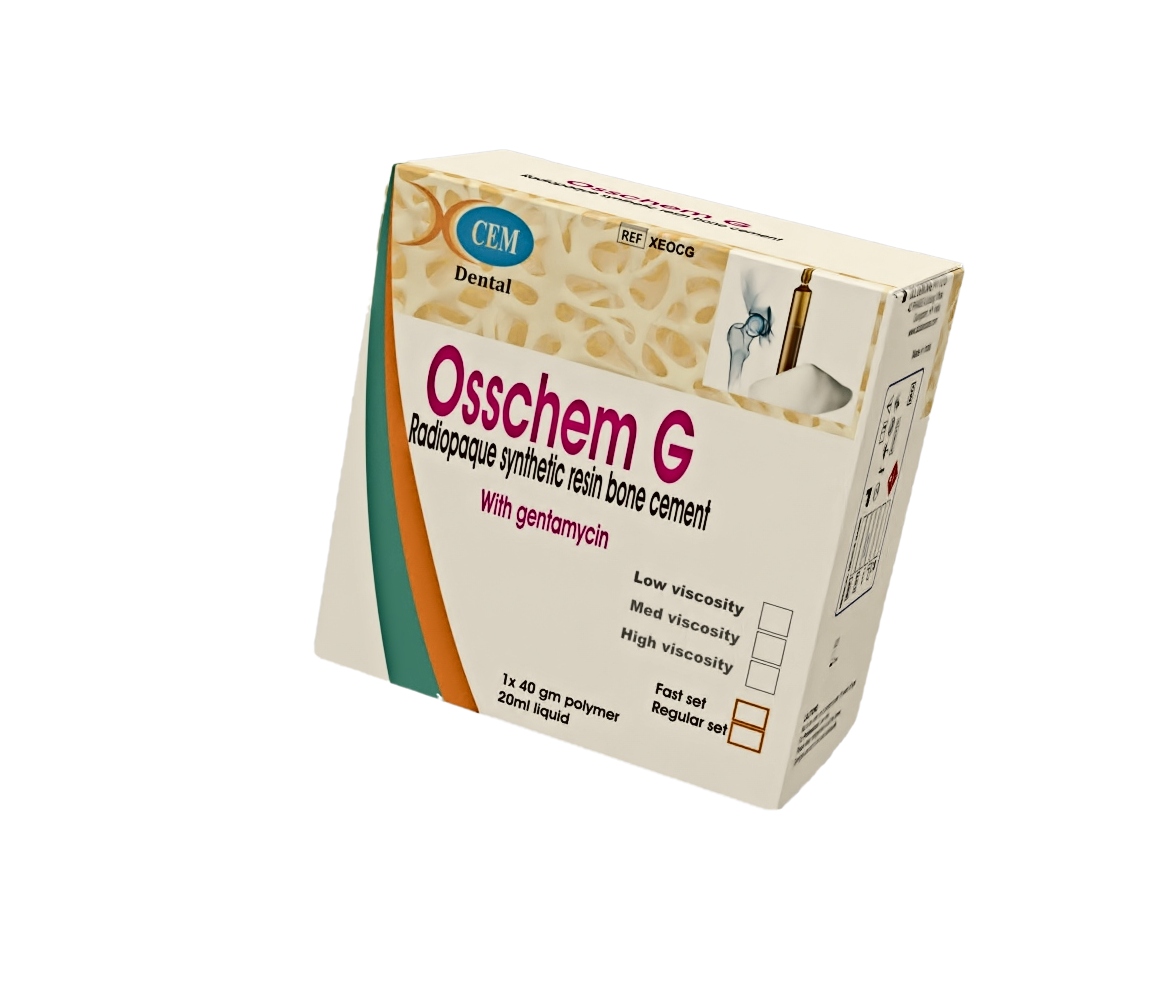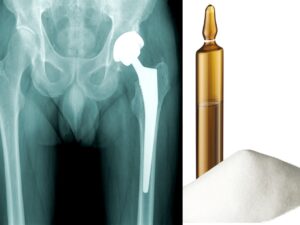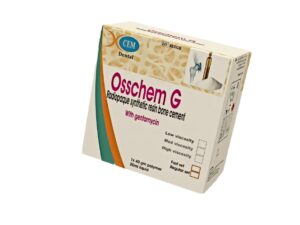orthopaedic resin bone cement with Gentamycin
ifu
DCL oscem Bone Cement
Bone cement is used for fixation of orthopaedic prosthesis to bone..
It is PMMA (polymethylmethacrylate) cement
When the monomer (liquid) and polymer (powder) are mixed, the polymerization reaction occurs to form hardened bone cement.
The liquid reacts with the polymer releasing the benzoyl peroxide, which reacts with N, N-dimethyl-p-toludine in the monomer, which accelerates the chemical reaction.
Monomer molecules polymerize to one another and form a chain.
Exothermic reaction occurs during this process of setting..
Considerations for Bone Cement Selection
Viscosity (consistency)
Low (runny) – Low viscosity cements
Medium – Medium viscosity cements can offer versatility for all procedure types
High (thick) – High viscosity cements have no runny state at all.
Porosity
Entrapped air in the bone cement (can be due to mixing technique and/or chemical composition of the cement)
Reduction of porosity results in better mechanical properties2
Mixing Bone Cement
Common Methods
Hand Mixing
The liquid and powdmixed in a plastic or stainless steel bowl using a spatula. Porosity may be increased and the cement strength may decrease.
Mixing process/technique
Vigorous mixing may accelerate the polymerization of the cement.
Powder-to-liquid ratio
Be sure to use the entire contents of the packaged liquid and powder.
Vacuum Mixing
Cement is mixed in air tight chamber connected to a vacuum source. Manufacturer’s specific instructions for mixing should be followed.
Vacuum mixing helps to eliminate most of the harmful fumes and to decrease porosity by removing entrapped air bubbles.
Compressive strength is higher with vacuum mixing. .
Mixing Process
Both the monomer and polymer are supplied sterile.
If any package is damaged, do not use or attempt to re-sterilize.
Empty contents of the sterile packet into a cement mixer or other suitable, non-reactive container.
Break open sterile glass ampule containing the liquid component
Add all of the liquid monomer to the powder in the mixing container..
Stir in a slow, with a sterile spatula or provided device until the powder is completely saturated.
Follow manufacturer’s instructions for the length of time to mix. When the mixture is non stick to surgical gloves, the cement is ready for implantation. (Mixing too long can result in insufficient working time for the surgeon.)
Factors affecting Setting Time
Temperature
a Polymer (powder) and Monomer (liquid) ratio.
Indications
Fixation of prosthesis to bone in orthopaedic surgical procedures due to following:
Arthritis: rheumatoid, osteo-, or traumatic
Avascular necrosis
Sickle cell anemia
Collagen disease
Severe joint destruction secondary to trauma or other conditions
Revision of previous arthroplasty
Fixation of pathological fractures where loss of bone substance of recalcitrance of the fracture renders more conventional procedures ineffective
Contraindications
Infectious arthritis
Active infection of the joint or joints to be replaced
History of such an infection
Allergies to any component
Factors that may Influence Cement Strength
Presence of contaiments such as water , blood or mucus.
Bone preparation
Medullary Plugs
May provide advantages including:
Greater intrusion pressure
Improved cement-to-bone interface strength
Fewer voids in the cement mantle
Containment of cement in the proximal portion of the femoral canal
Improved fixation
Porosity: Reduce porosity by vacuum mixing.
Pressurization: Safety Considerations
Flammability: The liquid monomer is highly volatile and flammable (open cup flash point of 50°F).Never bring a flame, spark, or other ignition source near the surface of the liquid ocured cement.
Do not expose the product or materials to high temperatures.
Cured bone cement is not a fire hazard.
Proper ventilation is important for minimizing the danger of
fire or explosion. (Typical well regulated OR ventilation is adequate.)
Proper storage of electrosurgical devices is important to avoid potentially dangerous situations.
Usual fire-fighting procedures are required in the unlikely event of a fire. Dry chemical foam or carbon dioxide extinguishers can extinguish the fire.Toxic gases and vapors, such as carbon monoxide, may be released in fires involving methylmethacrylate.spills and Disposal.
The EPA (Environmental Protection Agency) classifies the liquid (monomer) of bone cement as a volatile and flammable substance.8
In the event that the liquid spills, remove all ignition sources and ventilate the area.
Dispose of in accordance with local and federal regulations as hazardous waste.
Occupational Exposure
The surgical team is exposed to bone cement through skin contact and inhalation of its vapors. Team members should wear safety glasses and surgical gloves during the opening, pouring and mixing of bone cement.
methylmethacrylate as a potentially hazardous chemical. Safe practices should be established for its use. Personnel should read and follow all instructions provided by the manufacturer (Material Safety Data Sheets [MSDS], container label, Instructions For Use
[IFU]). Material
Safety Data Sheets should be accessible within the practice setting.
penetration by the vapors, therefore it is recommended that lenses of this type not be worn in the OR where methylmethacrylate is being mixed.
Skin Sensitivity
Never allow direct skin or other soft tissue contact with bone cement because it can cause a local reaction or be absorbed.
To reduce the risk of hypersensitivity reactions, you should double glove and discard the second pair of gloves after mixing.
It is possible for fumes to penetrate some types of surgical gloves, therefore double gloving is recommended.
OR personnel who use non-latex gloves should change to natural latex gloves before handling bone cement to prevent exposure.
Bone preparation
Medullary Plugs
May provide advantages including:
Greater intrusion pressure
Improved cement-to-bone interface strength
Fewer voids in the cement mantle
Containment of cement in the proximal portion of the femoral canal
Improved fixation
Porosity: Reduce porosity by vacuum mixing.
Pressurization: Safety Considerations
Flammability: The liquid monomer is highly volatile and flammable (open cup flash point of 50°F).Never bring a flame, spark, or other ignition source near the surface of the liquid ocured cement.
Do not expose the product or materials to high temperatures.
Cured bone cement is not a fire hazard.
Proper ventilation is important for minimizing the danger of
fire or explosion. (Typical well regulated OR ventilation is adequate.)
Proper storage of electrosurgical devices is important to avoid potentially dangerous situations.
Usual fire-fighting procedures are required in the unlikely event of a fire. Dry chemical foam or carbon dioxide extinguishers can extinguish the fire.Toxic gases and vapors, such as carbon monoxide, may be released in fires involving methylmethacrylate.spills and Disposal.
The EPA (Environmental Protection Agency) classifies the liquid (monomer) of bone cement as a volatile and flammable substance.8
In the event that the liquid spills, remove all ignition sources and ventilate the area.
Dispose of in accordance with local and federal regulations as hazardous waste.
Occupational Exposure
The surgical team is exposed to bone cement through skin contact and inhalation of its vapors. Team members should wear safety glasses and surgical gloves during the opening, pouring and mixing of bone cement.
methylmethacrylate as a potentially hazardous chemical. Safe practices should be established for its use. Personnel should read and follow all instructions provided by the manufacturer (Material Safety Data Sheets [MSDS], container label, Instructions For Use
[IFU]). Material
Safety Data Sheets should be accessible within the practice setting.
penetration by the vapors, therefore it is recommended that lenses of this type not be worn in the OR where methylmethacrylate is being mixed.
Skin Sensitivity
Never allow direct skin or other soft tissue contact with bone cement because it can cause a local reaction or be absorbed.
To reduce the risk of hypersensitivity reactions, you should double glove and discard the second pair of gloves after mixing.
It is possible for fumes to penetrate some types of surgical gloves, therefore double gloving is recommended.
OR personnel who use non-latex gloves should change to natural latex gloves before handling bone cement to prevent exposure.






